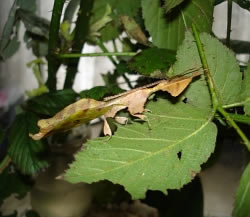Leaf Insect caresheet

A male Leaf Insect.
Leaf insects are very closely related to stick insects (they belong to the Order Phasmatodea) and, just as stick-insects camouflage themselves as twigs, the leaf insects are superbly camouflaged as a leaf (a process called crypsis).
Housing
Cages should be at least 30cm in height and can be made from fish tanks or garden propogators stood on end, plastic sweet jars or custom made netted cages. However, if anything other than a netted cage is used make sure that condensation does not build up on the inside of the cage or your insects will drown. This is especially important when housing insects in old sweet jars.
Feeding
Almost all species will eat sprigs of bramble (blackberry) leaves which can be found during the winter in sheltered places. Other alternatives are oak and evergreen oak. Whatever fooplant is used, care must be taken that the plant has not been sprayed with pesticides. Wash the leaves and place them in a small jar of water to keep them fresh. Take care to cover the jar with fine netting to stop any insects falling into the jar and drowning.
Young insects are often reluctant to feed. This is a particular problem with leaf insects. This can be overcome by introducing older feeding insects into the cage or by cutting the edges of the foodplant leaves with a pair of scissors to reveal fresh and mouth-watering leaf edges. It is also recommended that leaves are lightly misted with water every couple of days to allow the insects to drink - but be sparing!
Handling
When handling your leaf insects, gently coax them to walk on to the hand, as they will shed a leg very easily if handled roughly. Unless it is absolutely necessary, it is best not to handle the insects.

A female Leaf Insect.
Breeding
With luck, the females will begin laying eggs a few weeks after becoming adult. Each female will lay about 40 eggs at the rate of one or two per day.

The image above shows a Leaf Insect egg with ruler for scale (each division is 1 millimetre).
Place the eggs on moist silver sand in a plastic or perspex box with a tightly fitting lid. Keep the box at about 20-25°C. When the eggs hatch place the young onto fresh bramble which has had the edges cut to stimulate eating. This is the most crucial time in rearing these insects. With care, most species of leaf insects can be bred successfully.

A Leaf Insect nymph shortly after hatching.
Lost limbs
Leaf insects undergo incomplete metamorphosis. Sometimes, often if their cage is too dry, a leaf insect may have trouble shedding its old skin and will lose a limb in the process of moulting. If this happens it is possible for them to regrow the lost limb but only when they moult again. This means that, if your leaf insect is an adult, then it won't be able to regrow the lost limb.
Further information on Stick insects and Leaf insects.
Essential reading from the Amateur Entomologists' Society
- Rearing and Studying Stick and Leaf-insects (Vol. 22)
- The Amazing World of Stick and Leaf insects (Vol. 26)
Remember: it is important that you know the needs and requirements of your pet before you obtain the animal. You should never, ever obtain an animal before researching its needs and preparing the housing and conditions.

Want to know more?
If you want to know more about insects and other creepy-crawlies then join the AES today.
![Amateur Entomologists' Society home page [Logo]](/images/aes-logo-wplant.gif)